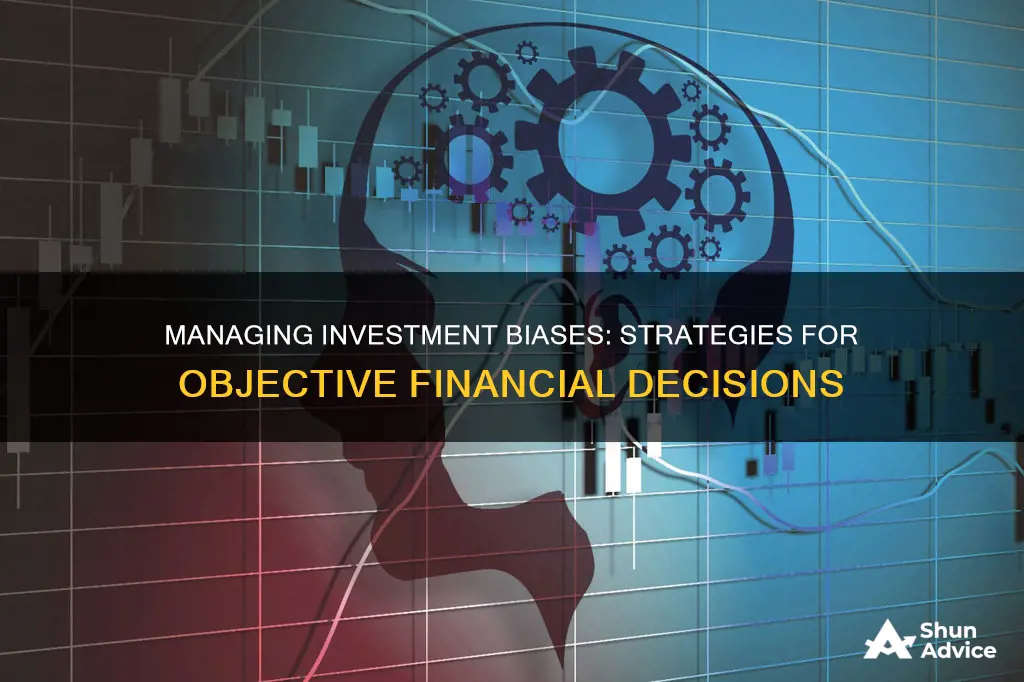
Making investment decisions is a complex process that is often influenced by our biases. Biases are irrational preferences or prejudices that cloud our judgment and lead us to make illogical choices. As humans, we are inherently susceptible to these biases, and investors are no exception. By understanding the common investment biases, we can aim to manage and reduce their impact on our financial decisions.
Some of the key biases that investors should be aware of include herding or herd mentality, where investors follow the actions of the majority, confirmation bias, which leads to favouring information that confirms existing beliefs, and overconfidence bias, where investors overestimate their knowledge and abilities. Loss aversion, endowment effect, and status quo bias are also prevalent, impacting investors' risk tolerance and decision-making. Additionally, cognitive biases such as anchoring bias and mental accounting bias can affect how investors process information and make comparisons.
Recognising and understanding these biases is crucial for investors to make more informed and rational decisions. By identifying when biases may influence their choices, investors can seek alternative viewpoints, conduct thorough research, and consult financial professionals to mitigate the impact of these biases and improve their long-term investment outcomes.
What You'll Learn

Recognise the impact of biases on decision-making
Recognising the impact of biases on decision-making is crucial for managing investment biases effectively. Biases are irrational preferences that affect investment decisions and outcomes. By understanding their influence, investors can make more rational and objective choices.
Behavioural biases are innate and result from our brains taking mental shortcuts to deal with a complex world. These shortcuts often lead to illogical decisions. For example, investors may fixate on marginal changes in wealth rather than overall wealth, leading to a focus on the wrong issues.
Various types of biases exist, including cognitive and emotional biases. Cognitive biases involve making decisions based on rules of thumb, while emotional biases are reactionary and rooted in personal feelings and beliefs.
- Anchoring or Confirmation Bias: The tendency to rely on first impressions and selectively filter information to support existing opinions while ignoring contradictory evidence.
- Regret Aversion Bias: Also known as loss aversion, this bias involves avoiding choices that may lead to regret, resulting in reduced risk-taking and reluctance to sell losing investments.
- Disposition Effect Bias: Labelling investments as winners or losers, leading to holding onto losing investments or selling winning investments too early.
- Hindsight Bias: The belief that past events were predictable, impacting future decision-making.
- Familiarity Bias: Investing in familiar options despite the benefits of diversification.
- Self-attribution Bias: Attributing success to personal actions and failures to external factors, leading to overconfidence.
- Trend-chasing Bias: Chasing past performance with the mistaken belief that historical returns predict future results.
By recognising and understanding these biases, investors can make more informed and rational decisions, reducing the impact of biases on their investment choices and improving their financial outcomes.
Robinhood Investing and Portfolio Management: A Beginner's Guide
You may want to see also

Identify and challenge your biases
Identifying and challenging your biases is a critical step in managing your investment biases. Here are some strategies to help you do that:
- Understand the common biases: Educate yourself about the various types of cognitive and emotional biases that can influence investment decisions. Examples include confirmation bias, loss aversion, endowment effect, status quo bias, and herding.
- Recognise your own biases: Reflect on your past investment decisions and try to identify instances where biases may have influenced your thinking. Be mindful of your personal beliefs, past experiences, and gut feelings when making investment choices.
- Question your assumptions: Challenge your initial impressions and actively seek out information that contradicts your existing beliefs. Consider alternative viewpoints and be open to adjusting your investment strategies based on new insights.
- Seek diverse perspectives: Consult with investment professionals, financial advisors, or diverse groups of people to gain different perspectives and challenge your biases. Their insights can help you make more informed and less biased decisions.
- Establish objective criteria: Develop clear and predefined criteria for making investment decisions. For example, set specific rules for buying or selling assets based on financial goals and risk tolerance, rather than emotional impulses.
- Focus on long-term goals: Maintaining a long-term perspective can help reduce the impact of short-term biases. Regularly review your investment portfolio and assess whether your decisions are aligned with your long-term financial objectives.
Savings and Investments: Planning for Your Future
You may want to see also

Develop an investment plan
Developing an investment plan is a crucial step in managing investment biases. Here are some detailed instructions to help you create a well-structured investment plan:
Identify Your Risk Tolerance:
Understanding your risk tolerance is essential before investing. Assess your financial situation, investment goals, and comfort level with market volatility. Are you comfortable with potential losses, or do you prefer a more conservative approach? Knowing your risk tolerance will guide your investment choices and strategies.
Diversify Your Portfolio:
Diversification is a powerful tool to mitigate the impact of biases. Spread your investments across various asset classes, sectors, and geographic regions. By not putting all your eggs in one basket, you reduce the potential damage caused by any single investment decision biased by your emotions or cognitive shortcuts.
Establish an Investment Strategy:
Develop a clear, written investment strategy that outlines your goals, time horizon, and the strategies you will use to achieve those goals. This strategy should be based on thorough research and analysis, considering both fundamental and technical aspects of the market. It will help you stay disciplined and avoid emotional decisions.
Set Clear Criteria for Buying and Selling:
Define the criteria that will trigger buying or selling decisions. For example, you might decide to buy a stock if it meets specific financial metrics or industry trends and set a trailing stop to limit potential losses. Having predefined rules will help you avoid the emotional rollercoaster of investing and make more rational decisions.
Monitor and Rebalance Your Portfolio Regularly:
Regularly review your portfolio's performance and adjust it as needed to stay aligned with your investment strategy. Monitor your investments for any signs of bias creeping in, such as favouring certain stocks due to familiarity or confirmation bias. Periodically rebalance your portfolio to maintain your desired asset allocation and risk level.
Seek Professional Advice:
Consider working with a financial planner or adviser who can provide an objective perspective on your investment decisions. They can help you identify and manage your biases, offering strategies to minimise their impact. Remember, even the most experienced investors can fall prey to biases, so having a professional sounding board can be invaluable.
Developing an investment plan is a continuous process that requires discipline and self-awareness. By following these steps, you'll be better equipped to manage your investment biases and make more informed decisions.
Portfolio Investment: A Long-Term Financial Journey
You may want to see also

Understand your risk tolerance
Understanding your risk tolerance is a critical aspect of managing investment biases. Here are some detailed insights on this topic:
Understanding Risk Tolerance:
Risk tolerance refers to the amount of risk an individual is willing to take in their investment decisions. It is a crucial aspect of financial planning as it helps determine the appropriate investment strategies and asset allocation for each investor. Understanding your risk tolerance involves assessing your comfort level with different levels of risk and the potential impact on your financial goals.
- Investment Goals: Start by defining your financial goals and the time horizon for achieving them. Different goals, such as retirement planning, saving for a child's education, or building an emergency fund, will have varying risk tolerances. Long-term goals typically allow for more risk-taking, while short-term goals may require a more conservative approach.
- Risk Capacity: Evaluate your financial capacity to take risks. Consider your current financial situation, including income, expenses, debt obligations, and liquidity needs. If you have a stable income, ample savings, and a comfortable cushion for unexpected expenses, you may have a higher risk capacity.
- Risk Personality: Reflect on your personal attitude towards risk. Some people are naturally more risk-averse, while others are more comfortable taking on higher risks. Be honest with yourself about your emotional response to market volatility and the potential for losses.
- Investment Knowledge and Experience: Your level of investment knowledge and experience can influence your risk tolerance. If you are well-informed about the markets and have experienced different market cycles, you may feel more comfortable taking on risk. However, a lack of knowledge or experience may warrant a more conservative approach.
- Diversification Preferences: Consider your views on diversification. Diversification across asset classes, sectors, and geographic regions is a key risk management strategy. Diversification can help reduce the impact of market fluctuations and lower the overall risk of your portfolio.
Determining Your Risk Tolerance:
Once you have considered the above factors, you can determine your risk tolerance level, which is often described as conservative, moderate, or aggressive. Here are some additional tips to help you in this process:
- Risk Tolerance Questionnaires: Many financial institutions and investment platforms offer risk tolerance questionnaires. These tools can help you assess your risk tolerance by asking a series of questions about your financial situation, goals, and comfort with risk.
- Historical Market Scenarios: Consider how you would have reacted to different historical market scenarios, such as the 2008 financial crisis or the more recent market volatility triggered by the COVID-19 pandemic. Reflect on the actions you would have taken and the emotional impact of those events.
- Dollar Amounts vs. Percentages: When evaluating risk, consider both dollar amounts and percentages. For example, a $10,000 loss may seem more significant when expressed as a dollar amount, while a 10% loss may carry more weight when expressed as a percentage.
- Risk Capacity vs. Risk Tolerance: Distinguish between risk capacity and risk tolerance. Risk capacity refers to your financial ability to take on risk, while risk tolerance reflects your psychological willingness to do so. You may have the capacity to take on more risk but may not be emotionally comfortable with it.
- Review and Adjust: Risk tolerance is not static; it can change over time as your financial situation, goals, and market conditions evolve. Regularly review and adjust your risk tolerance assessment to ensure it remains aligned with your circumstances.
Understanding your risk tolerance is a critical step in managing investment biases. It helps you make informed investment decisions, allocate your assets appropriately, and maintain a long-term perspective, reducing the influence of emotional biases. By assessing your risk tolerance, you can design an investment strategy that aligns with your financial goals and comfort level, enabling you to stay on track and make more rational investment choices.
Managing Venezuela's Future: Foreign Investment and Aid
You may want to see also

Consult a financial adviser
Consulting a financial adviser can be an effective way to manage investment biases and improve long-term investment outcomes. Financial advisers can help identify and moderate the impact of biases, providing valuable insights and guidance to investors. Here are some reasons why consulting a financial adviser can be beneficial:
- Expertise and Objectivity: Financial advisers are trained to recognize and mitigate the impact of investment biases. They can provide an objective perspective, helping investors make rational and well-informed decisions. By seeking their expertise, investors can gain a deeper understanding of their behavioral biases and learn strategies to manage them effectively.
- Behavioral Finance Expertise: Behavioral finance is a field that combines psychological theory with financial economics to predict and manage investment behaviors. Financial advisers well-versed in behavioral finance can help investors recognize and overcome their biases. They can offer customized investment plans that take into account an individual's risk tolerance, investment goals, and behavioral tendencies, thus reducing the influence of biases.
- Investment Plan Customization: Each investor has unique behavioral biases, risk tolerances, and financial objectives. Financial advisers can help create tailored investment plans that align with these factors. By understanding an investor's specific biases, advisers can implement strategies to minimize their impact. This customization can lead to more effective investment decisions and potentially improve long-term financial outcomes.
- Emotional Support and Guidance: Investing often involves complex emotions, such as fear, greed, and overconfidence. Financial advisers act as a sounding board and provide emotional support to help investors manage these feelings. They can offer guidance to prevent impulsive decisions driven by emotional biases. By encouraging a disciplined and rational approach, advisers can help investors stick to their investment strategies and avoid costly mistakes caused by emotional biases.
- Regular Portfolio Reviews: Financial advisers conduct regular portfolio reviews to ensure investments remain aligned with the investor's goals and risk tolerance. These reviews help identify areas where biases may be influencing decision-making. By proactively addressing these issues, advisers can keep investors on track and potentially prevent detrimental financial choices. Regular reviews also allow for course corrections, ensuring that investment strategies remain suitable over time.
By working closely with a financial adviser, investors can gain valuable insights into their behavioral biases and learn strategies to manage them effectively. This collaboration can lead to more informed and disciplined investment decisions, potentially improving long-term financial outcomes.
Aggressive Investment Portfolio: High-Risk, High-Reward Strategy
You may want to see also
Frequently asked questions
Bias is an irrational assumption or belief that affects the ability to make a decision based on facts and evidence. Biases are a natural part of human decision-making, but they can cause people to make irrational choices. Psychologists have identified more than a dozen kinds of biases, and any or all of them can cloud the judgment of an investor.
Some common types of investment biases include:
- Confirmation bias: favouring information that confirms pre-existing beliefs.
- Overconfidence bias: excessive confidence in one's investment decisions and abilities.
- Loss aversion: fearing loss more than desiring gain.
- Endowment effect: overvaluing assets because of ownership.
- Status quo bias: resistance to change.
- Herd mentality: following the actions of a larger group.
- Anchoring bias: relying too heavily on a past reference or a single piece of information when making decisions.
It's important to be aware of your biases and how they might impact your decision-making. Recognising the presence of biases, identifying when they might arise, and making appropriate adjustments or obtaining help to moderate their impact can help reduce their influence. Working with a financial planner can also help investors recognise and understand their individual behavioural biases.
Relying on biases rather than hard data can be costly. Investment biases can lead to suboptimal portfolios, increased risk of losses, and poor investment decisions.







